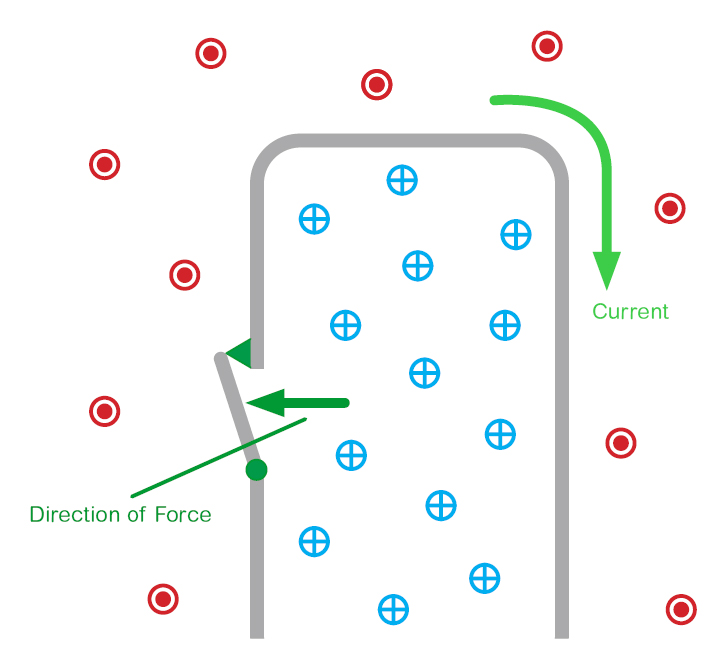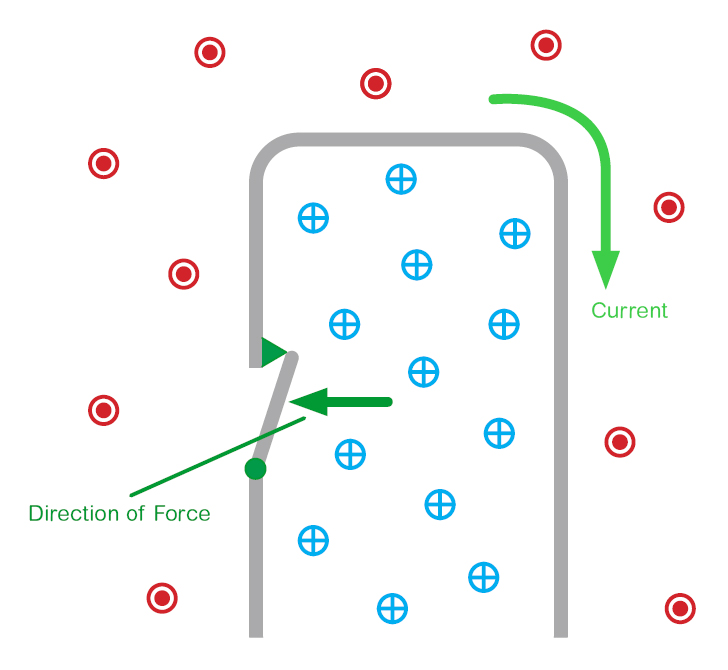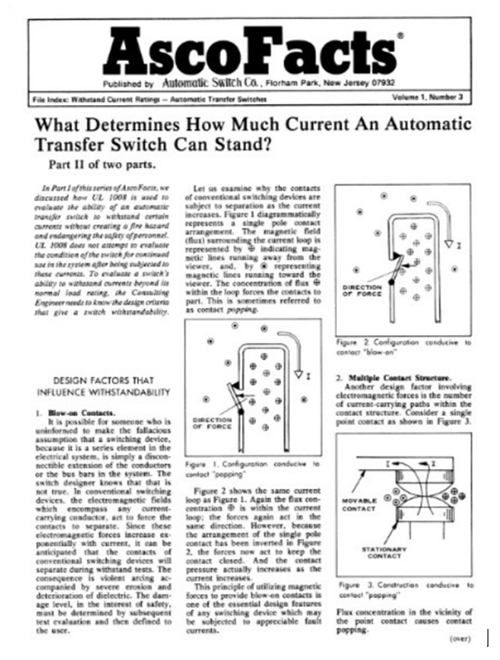A transfer switch transfers electrical loads between two power sources, typically a utility power supply and a backup generator. The switch must be capable of continuously carrying its rated amount of electrical fault current because it is always connected to a power source. This article explains a straightforward design principle that enables ASCO transfer switches to withstand and close-on large fault currents, outcomes that enhance power reliability and availability.
Conventional Contact Mechanism Design
In a conventional transfer switch, electromagnetic fields in current-carrying conductors apply force to switching mechanisms. This force is illustrated in Figure 1, where the magnetic flux moving away from the viewer is represented by ⨁ and the flux extending toward the viewer is represented by ◉. The resulting force attempts to thrust the contact mechanism leftward. If current reaches sufficient levels, it could force the contracts open, causing an electrical outage.
 Figure 1: In this arrangement, electromagnetic force from large fault current could drive the switching contacts apart.
Figure 1: In this arrangement, electromagnetic force from large fault current could drive the switching contacts apart.
The Problem with Contacts Opened by Fault Currents
Figure 1 illustrates a scenario where a fault occurred, a transfer switch opened, and the current stopped flowing. When faults occur, equipment in the power distribution system should cause current to stop flowing to limit equipment damage and avoid safety hazards. However, the problem here is that the wrong device cleared the fault.
Because the transfer switch opened, it is possible that the upstream breakers feeding the transfer switch remained closed. If someone tries to reclose the transfer switch on the live circuit without properly correcting the fault, the transfer switch contact may not be able to close on the fault current, extending the outage. Likewise, if someone deenergizes the circuit, closes the transfer switch, then re-energizes the circuit without clearing the fault, the transfer switch will reopen and the outage will continue. These scenarios are two of the reasons why UL 1008 requires testing to verify both
withstand and close-on ratings for transfer switches.
What are Blow-On Contacts?
Blow-on contact mechanism designs invert the movement of the transfer mechanism so that the electromagnetic forces will drive the contacts to close more tightly with increasing current, enabling the switching contacts to withstand and close on greater fault currents. Figure 2 shows this arrangement together with the electromagnetic effects forcing the inverted contact mechanism to be closed. The exerted force is the same as shown in Figure 1, but causes the pressure on the contacts to increase, keeping them together.
 Figure 2: In this arrangement, electromagnetic force from a large fault current drives the switching contacts together, helping them to conduct current until the fault is cleared by an overcurrent protection device.
Figure 2: In this arrangement, electromagnetic force from a large fault current drives the switching contacts together, helping them to conduct current until the fault is cleared by an overcurrent protection device.
While blow-on contact technology is an important reason ASCO transfer switches offer class-leading
Withstand and Closing Ratings, it is not new to ASCO’s renowned transfer switches. Figures 1 and 2 were originally published in a 1974 edition of ASCOFacts, a technical newsletter issued to educate specifying engineers and the backup power community about transfer switch products. Access a digital copy of the publication
here.
 Figure 3: ASCO's 1974 description of blow-on contact technology
Figure 3: ASCO's 1974 description of blow-on contact technology
Summary
Transfer switches play a key role in maintaining power availability and powering mission-critical loads. For over 40 years, ASCO Power Technologies has continued to improve power availability by incorporating features such as blow-on contacts in its designs. This simple feature helps transfer switch contacts stay closed and reduces the opportunity for fault current to disrupt power flow and facility operations.
Learn more about this design feature and its value in power systems by contacting an
ASCO Power representative today.




